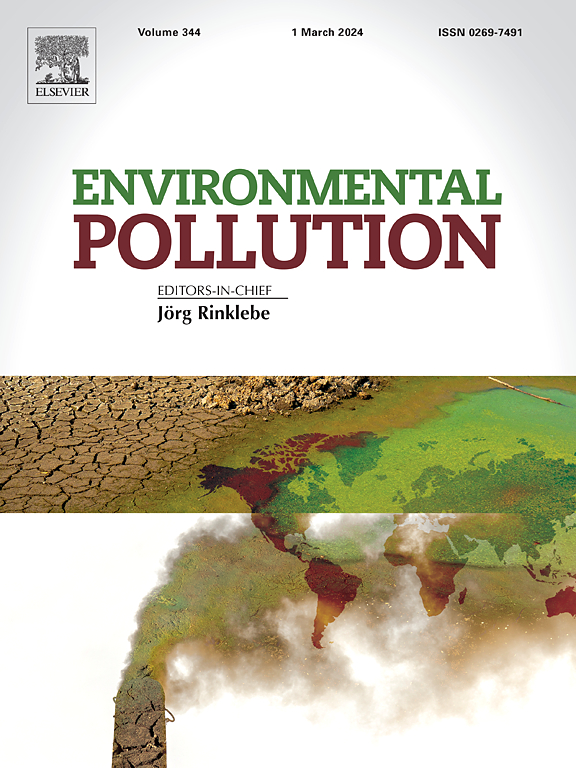Toxicity of real-world PM2.5 road tunnel emissions using a mobile air-liquid interface system and submerged exposure
IF 7.6
2区 环境科学与生态学
Q1 ENVIRONMENTAL SCIENCES
引用次数: 0
Abstract
Traffic-related air pollution is a major public health concern, contributing to respiratory and cardiovascular diseases worldwide. The aim of this study was to investigate the feasibility of using a mobile Air-Liquid Interface (ALI) system to assess the cytotoxicity and inflammatory potential of freshly generated PM2.5 (particle matter with aerodynamic diameter <2.5 μm) in a road tunnel in Stockholm. We hypothesized that cellular effects would be detectable at lower doses compared to submerged exposures. The mean particle dose in ALI was 1.4 ± 0.8 μg/cm2, whereas a wide range of doses was used for submerged exposures. ALI and submerged results showed that PM2.5 from the road tunnel did not affect the viability of A549 cells, whereas a significant and dose-dependent decrease in viability of dTHP-1 (in submerged exposure) was observed. Furthermore, in A549 in ALI a slight increase in inflammatory response (IL-8, IL-6, and IL-1β) was observed. In submerged exposure, the inflammatory response was clearer, particularly in the dTHP-1 cells. In conclusion, this study presents the first successfully conducted in situ ALI exposure in a road tunnel. The results demonstrate that dTHP-1 cells exhibit clear cytotoxic and inflammatory responses, while A549 show only weak effects. These findings suggest that co-cultures of A549 and dTHP-1 may be valuable in future ALI studies.
使用移动气液界面系统和水下暴露对真实世界PM2.5道路隧道排放物的毒性
与交通有关的空气污染是一个主要的公共卫生问题,在全世界造成呼吸系统和心血管疾病。本研究的目的是研究使用移动气液界面(ALI)系统评估斯德哥尔摩公路隧道中新产生的PM2.5(空气动力学直径为2.5 μm的颗粒物质)的细胞毒性和炎症潜力的可行性。我们假设,与浸泡在水中的暴露相比,在较低剂量下可以检测到细胞效应。ALI的平均颗粒剂量为1.4±0.8 μg/cm2,而浸泡暴露的剂量范围很广。ALI和淹没结果表明,公路隧道PM2.5对A549细胞的活力没有影响,而dTHP-1的活力(在淹没暴露下)显著且剂量依赖性地下降。此外,在ALI的A549中,观察到炎症反应(IL-8, IL-6和IL-1β)略有增加。在浸泡暴露中,炎症反应更明显,特别是在dTHP-1细胞中。总之,本研究首次成功地在公路隧道中进行了原位ALI暴露。结果表明,dTHP-1细胞表现出明显的细胞毒性和炎症反应,而A549仅表现出微弱的作用。这些发现表明A549和dTHP-1的共培养可能在未来的ALI研究中有价值。
本文章由计算机程序翻译,如有差异,请以英文原文为准。
求助全文
约1分钟内获得全文
求助全文
来源期刊

Environmental Pollution
环境科学-环境科学
CiteScore
16.00
自引率
6.70%
发文量
2082
审稿时长
2.9 months
期刊介绍:
Environmental Pollution is an international peer-reviewed journal that publishes high-quality research papers and review articles covering all aspects of environmental pollution and its impacts on ecosystems and human health.
Subject areas include, but are not limited to:
• Sources and occurrences of pollutants that are clearly defined and measured in environmental compartments, food and food-related items, and human bodies;
• Interlinks between contaminant exposure and biological, ecological, and human health effects, including those of climate change;
• Contaminants of emerging concerns (including but not limited to antibiotic resistant microorganisms or genes, microplastics/nanoplastics, electronic wastes, light, and noise) and/or their biological, ecological, or human health effects;
• Laboratory and field studies on the remediation/mitigation of environmental pollution via new techniques and with clear links to biological, ecological, or human health effects;
• Modeling of pollution processes, patterns, or trends that is of clear environmental and/or human health interest;
• New techniques that measure and examine environmental occurrences, transport, behavior, and effects of pollutants within the environment or the laboratory, provided that they can be clearly used to address problems within regional or global environmental compartments.
 求助内容:
求助内容: 应助结果提醒方式:
应助结果提醒方式:


